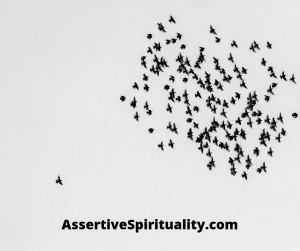
The Complexities of Ostracism
As I post this we’re just entering Advent on the Christian liturgical calendar—and that means we’re entering a new year as well as a season when many are being asked to listen to voices “crying out in the wilderness.” The problem, of course, is that toxic societal patterns and trauma alike often push people to the wilderness and then tell us that their voices ought not to be heard. Whether or not you follow Christianity or practice Advent, hopefully this article will be useful to you in your understanding a few of the complexities of ostracism/isolation of those who speak truth to power (including to religious institutions), how it happens, and how to diagnose and deal with such situations.
Disclaimer: as with most topics regarding communication and conflict, I could talk for weeks about this. Please know that there’s a lot of thought behind this article, and that it’s not meant to be comprehensive (and yet, yup, it’s long–thanks for your patience!). 🙂
Why Focus This Series of Articles on Advent Themes?
Okay, so I’m an Advent nerd—so bear with me if you’re not as into that, because I promise what I say about ostracism and isolation is relevant for a wide range of people, whether or not you care about Advent. But I’ve long loved this quirky Christian church season that gives us room to grieve the waiting for justice and to provide motivation to help create a better world in a time when everyone’s so stressed out, and so that’s my frame for the next few articles.
In seasons like that in the US now, it feels like Advent is such the appropriate rhetorical response for this time, with its incredibly, disturbingly-relevant-to-the-world-today readings calling out religious leaders being broods of vipers and whatnot (check out Luke 3:7-18—incredibly powerful). And so in this season’s blog posts I want to unpack some of the themes that arise for me from these readings that intersect with and correspond to the political situation and the tools from my life and expertise in communication.
Warning: for the Advent liturgy nerds out there, these won’t correspond with the Bible verses chosen for the “right” weeks in the liturgy, nor will they be comprehensive. I’m not THAT much of an Advent nerd. 😉
Not Trying to Convince You that the People I’m Talking about Are “Called”
Okay, so let’s start by recognizing that voices that cry in the wilderness are often those who have gone out in the wilderness–away from mainstream structures. In the world of spirituality, there is often an assumption that a “prophet” such as John the Baptist (who is the man mentioned in the Advent readings as the “voice crying in the wilderness) has a “call” to go out into the wilderness.
I have neither time nor will to address the complexity of that particular question here. But I do hope to complicate the picture of what happens with prophets and the ways people and organizations take part in dismissing their messages.
As you’ll see, I think you should be speaking up for and with people who are ostracized by for their convictions and those of the least of these they defend as well as you can, especially those confronting “political disgusts” about the least of these, human rights abuses, or confronting all kinds of abusive behavior, and asking for them as well as those they are defending to be treated justly and with full human dignity. Even if you disagree with their theological or political stances.
And that means searching your own complicity in various intentional and unintentional forms of ostracism. You should of course, as I said in the last article, count the costs before you choose speak up, either as a prophet or on their behalf. But that doesn’t mean it might not be the right thing to do to speak up on behalf of our modern-day John the Baptists, as well as to become one of the crowd of us weirdos out here in the wilderness.
Current Analogues to John the Baptist
So yes, what I want to talk about is the current methods churches and other institutions and groups use to ostracize people, and put that into context using some helpful organizational communication theory about ostracism and isolation.
So how does all of this fit in with John the Baptist? Here’s the thing—John the Baptist obviously had strong convictions. He may or may not have chosen his isolation and the weird stuff he ate and wore willingly. But he also called out the religious leaders of his day as broods of vipers. He stood up and spoke truth to power, both religious and political. He ultimately paid dearly for his choices to speak truth to power.
He was a pretty weird guy who had an audience. But he was not normal or nice. And it’s frankly strange how much we’ve normalized and whitewashed his position in the Christmas story today. And I’m calling hypocrisy on the way many are celebrating his place in the Christmas story while also participating in or supporting ostracism of similar types of voices today.
Some Concrete Examples
To give concrete examples here, I’m thinking of Jen Hatmaker and others who have challenged conservative Evangelical viewpoints that the church has so closely associated what I’ve previously called “political disgusts.” As far as I can tell, Jen Hatmaker didn’t actually call anyone broods of vipers to gain her death threats and snarky dismissals as a heretic and worse, but merely announced that she and her husband were planning to make their church fully welcoming to those in same-sex relationships.
And as she discussed at the recent Evolving Faith conference, she definitely entered the wilderness for that change. Some of that was purposeful by thoughtfully claiming her convictions. But she didn’t just isolate herself from her position–there were definitely strong ostracism factors at play as well.
I’m also thinking about the African American black rap band Lecrae, who had been popular with white evangelicals, but felt criticism and consequences when they spoke up in favor of racial justice issues—which is a problem with current conservative political stances but not with the biblical text, from what I can see.
I’m also thinking about those who have called both the Catholic church and Evangelical churches out on toxic #churchtoo issues and faced intense opposition for it.
Definitions of Ostracism and Isolation

But first, to what ostracism is. We often associate ostracism only with active intentional casting out of people from groups. The truth is that it really describes a thousand ways in which communities exclude people from full participation in their midst and/or avoid giving them full dignity and/or credibility.
It is also paired with a flip side of the coin concept: that of isolation—in which someone keeps themselves from full participation in a group or organization for a variety of reasons.
Both of these concepts are key to consider, as well as the wide range of reasons for them. Ostracism and isolation are both really common, and have healthy and unhealthy forms.
This article will specifically take on more of the issues surrounding unhealthy forms of ostracism.
Ostracism: A Range
One of my favorite things from the chapter I teach in my ostracism unit in my university communication classes is a chart that draws attention to the difference between active and passive, intentional and unintentional ostracism.
I won’t reprint it here because I didn’t ask for permission, but it’s a basic axis with 4 quadrants based on an active/passive axis intersection with an intentional/unintentional axis. Various terms for types of ostracism are scattered among the quadrants. Bullying and depersonalization, for instance, are active and intentional, whereas ignoring can be either passive intentional or passive unintentional.
(If you’re curious, it’s in the book Destructive Organizational Communication, edited by Lutgen-Sandvik and Sypher, in a chapter by Patricia M. Sias.)
This chart and the range of types of ostracism it shows is so important to breaking down the dichotomies in thinking about ostracism as well as helping us to diagnose the correct types for a given situation. This is really important in an era where there is so much debate and confusion, for instance, over what bullying actually is.
Well, That Feels a Bit Better (Because Definitions Give Us Something to Act On)
When we have a range of definitions to work from, it helps. But diagnosing each case is still complex. We will still have to negotiate definitions in given situations—because communication is ambiguous, and perceptions nearly always vary, especially in conflict situations. And because meaning is always co-creation between the author and audience, and that often involves conflict. But at least then it’s easier to get to that definition.
Only through recognizing these things and the factors that lead to them can we really diagnose when we and others are participating in any of these forms, figure out whether they are healthy or unhealthy form, and figure out how respond adequately.
Why Those Who Have Ears to Hear Don’t Always Hear
Here’s the thing, though. Even when people are doing unhealthy forms of things in the “active intentional” range of ostracism, such as bullying or mobbing, they are often driven by stress and shame reactions. And shame is a form of stress—I talk about stress reactions more in the “Assertive Spirituality Guide to Trolls,” which you can get by signing up for the email newsletter in the top bar of this site.
Also note that if you’re in the spot of having spoken up against abuse, that doesn’t mean you can (or ought to be able to) control audience reactions. You can speak prophetically, and be right. (You can also speak up prophetically and be partly or wholly wrong which is why it’s sooo important to be mindful when you choose to.) You can even cushion your words to try not to hurt your audience too much—by trying to be measured in how you communicate.
But if the other party takes your words or ideas to be a threat in some way, some of them may react as though you are a threat, whether to a system of thinking, to a way of life, or to an existing power structure.
People having these visceral responses and then acting on them in unhealthy ways is often why the unhealthy forms of ostracism happen.
The Genuine Threats of Speaking Up
If you speak up publicly against things strongly associated with political disgusts, specifically, some people in your audience may seek to ostracize you in really unhealthy ways, up to and including really actively seemingly intentional ways such as the death threats offered to Jen Hatmaker–or, in more extreme cases, the actual death delivered to Jesus, John the Baptist, and modern prophets such as Martin Luther King, Jr.
(And let’s be honest here–not all causes are worth standing up against as overtly as this. Especially in situations where danger is genuine, everyone needs to make their own decisions. Difficult decisions are difficult. Also, note that simply being a jerk is ideally different from speaking up prophetically, though they may look the same at times (cf. John the Baptist’s “You brood of vipers”).)
The Difference Between Intentionality and Awareness
Here’s the weird part: even when they choose their actions really strongly, these members of the audience who seek to ostracize the person critiquing them may react this way without fully understanding their motivations.
Most people have many conscious decision points when they choose to perpetrate unhealthy intentional forms of ostracism.
But when some people are acting out of felt threat in a reactive way—that is, just letting their stress impulses take over and not seeking to appropriately channel or reduce them—some people will get aggressive. (Note that there are healthy responses to anger–it can be useful, and channeled in productive ways. But also unproductive, hurtful ones. We’ll talk about productive anger at some point–the prophetic voice often comes out of it.)
Also note that people’s biases and “religio-political disgusts,” (including our own!) are also socialized into them (us!) as well, and must consciously be fought should the person choose to change them. Because sometimes these things get all mixed up in our prophetic voice, or our response to prophetic voice from another.
Felt threat + decisions to go with the visceral reaction to hurt or exclude someone–that’s often the formula for how the more unhealthy “active, intentional” forms of ostracism come about. And none of us is perfectly free from bias. The large majority of us have shame. We all have stress reactions that catch us off-guard from time to time. All of which muddies the waters a bit.
But note that there are healthy variations–mostly situations where it’s not ideal, but still necessary to exclude or step away from people (also note that ostracism is done by, or at least allowed by, a group. It’s not exactly ostracism if an individual is stepping away from a group–that’s isolation). Often this is because of the complexities of love and limits of the sort I’ve talked about previously.
How “Christian Nice” Fits In
Of course, not all people will be overtly aggressive if you speak up about things that violate their “religio-political disgusts.” Some will practice the things more on the intentional and unintentional sides of the “passive” spectrum, such as shunning, ignoring, and oblivious ostracism. This too can be hurtful and/or traumatic for some people.
“Christian Nice” and Depersonalizing Language
I would argue that snarky articles explaining theologically why prophetic voices are less important are also passive aggressive, but still fit on the active-intentional scale—because they fit in really well with what Sias categorizes on the active intentional side: depersonalization. This strategy is one that considers a person or their viewpoints or experiences “less than” if they don’t fit into the group’s standard frame.
I didn’t even realize how often and frequently this has long been practiced in the church until I went through the transformation surrounding my divorce, which I described here.
Now I genuinely can’t unsee the many ways that voices of those who have been ostracized from the church who have valid points of concern are invalidated and shamed for that through the “sacred language of depersonalization,” often delivered with much shaking of heads and gnashing of teeth about the person’s eternal soul.
I see the damage now. I also see how these things are grounded in fearful reactions to felt threat. I empathize. But that doesn’t mean the hurtful behavior is okay.
What They Mean When They Say Claiming Neutrality Is to Be on the Side of the Oppressor
When people talk about neutrality being a position on the side of the oppressor, they are often referring to the ways in which others who disagree with any of this treatment—or who have been socialized into the societal “political disgusts” to such a point that as I described about my past experience they may feel vaguely uneasy about the way the church overemphasizes the issues around political disgusts and yet never enough to act—stay silent, and thus enable the issues.
These people may actually speak up to those they know also disagree with the treatment of people like Jen Hatmaker. They may even say overtly, especially in private conversations, that the death threat part of her treatment is clearly wrong.
And they may have good reason to stay silent—after all, the death threats are a pretty strong argument to stay silent, right? Who wants to be martyred like John the Baptist, or to face the other social penalties that often come with speaking up against powerful systems—living out in the wilderness with the other “weirdos” instead of in the seemingly safe confines of the walled village?
It’s Time to Put Off “Christian Nice”
The complex problem, of course, as I’ve described since the first article on the toxic sides of “Christian Nice,” is that abuse and unhealthy ostracism alike can only thrive in situations where enough dissenters stay silent.
But it still boils down to this: if enough people speak up, especially those inside the system that’s ostracizing prophets, in support of the prophetic voices, justice is more likely to be done.
I will argue here and now that even those who themselves feel conflicted about the beliefs of those on the outside should be speaking up against any bullying and depersonalization on your side of whatever fence you’re on, as much as you can.
That’s true even if you disagree with someone’s religious beliefs or politics. They don’t deserve to be stripped of their dignity. You don’t have to agree with everything they say to give them that.
Let’s Do Our Best to Speak Out
You should of course count the costs before doing speaking up, as I already mentioned. But it really is possible to be complicit in much wrongdoing against the least of these if you don’t do what you can, where you are, with what you’ve got. Even if you quietly voice your objections to blatantly unjust, unmerciful, unkind, and genuinely hurtful behaviors, please speak up, friends, as you can.
Go team #AssertiveSpirituality! Let’s all do what we can to fight for the human dignity of all. We can do this thing.


3 thoughts on “The Complexities of Ostracism”
A good article. It gave me some peace of mind. Thank you.
Good article on Assertive Spirituality.